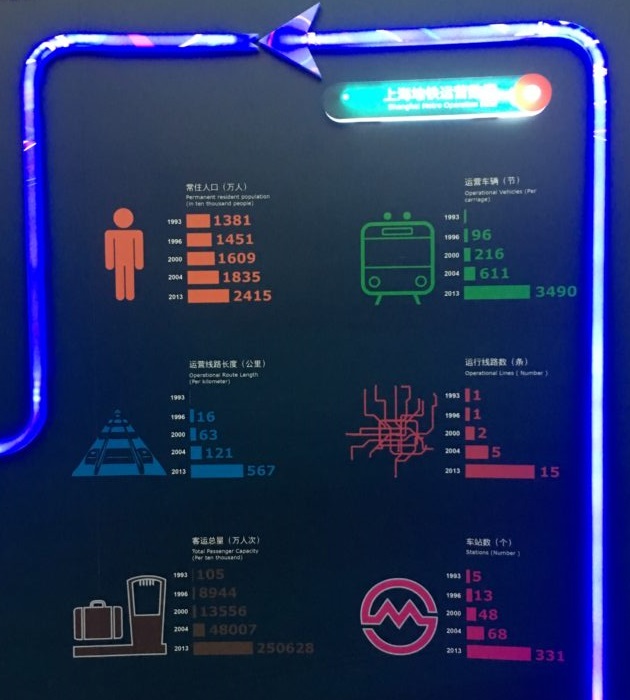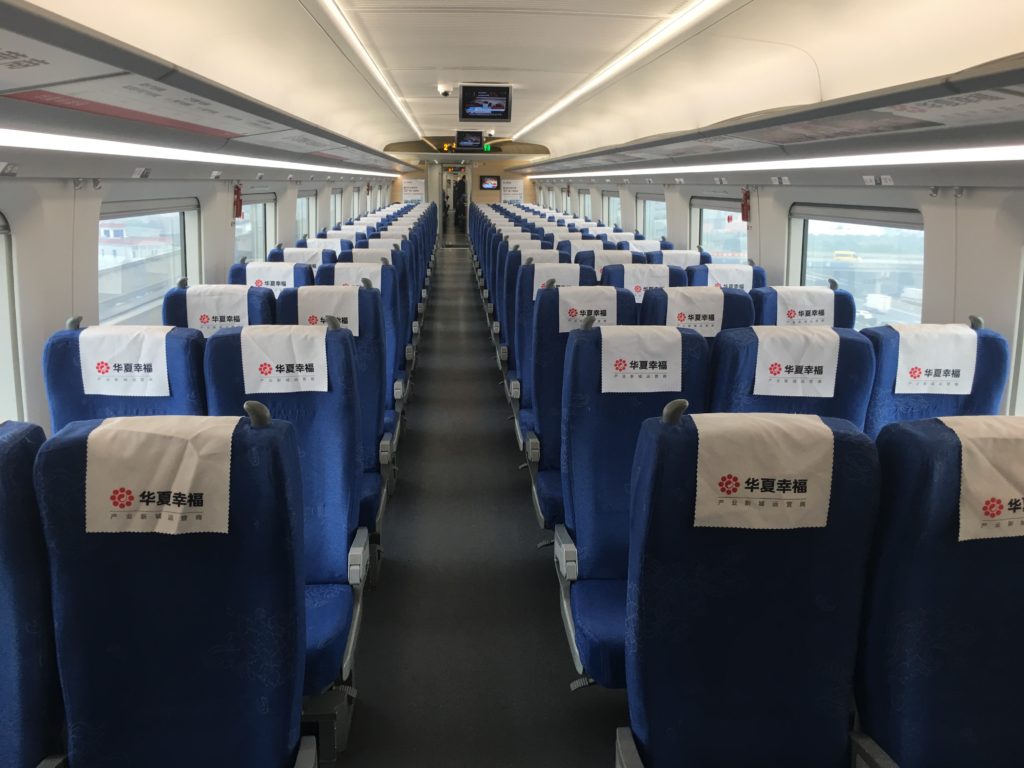During our trip to China over the winter holidays, we took three trips on Chinese high-speed trains:
- Shanghai to Hangzhou – 99 miles, 52 minutes
- Chengdu to Leshan – 62 miles, 1 hour
- Chengdu to Xi’an – 528 miles, 4 hours, 15 minutes
I was really impressed with our experiences. The trains were clean, modern, reasonably comfortable, very punctual, and extremely reasonably priced – the shorter trips cost $8-12 USD per person, and the longer one was $62 USD in first class – much cheaper than flying.
Understanding China’s High Speed Trains
China’s high speed rail network is rapidly growing. There are currently five different types of trains running on the network, but they’re all pretty similar – either an 8 or 16 car train, consisting of mostly second class cars (with a 3-2 seating configuration), a first class car (wider 2-2 seats with an immovable armrest between each pair), and sometimes a business class section (business is higher than first). All seats are assigned, and you’ll always face the direction of travel – the seat sets rotate 180° when released with a foot pedal, so if you get off at a terminus station you may see the staff walking through and spinning the seats around for the return trip.
From what I can tell, all trains appear to feature Western-style toilets and boiling water dispensers, and most trains have food available for purchase. There are overhead luggage racks that fit standard carry-on luggage, and some cars have compartments or open spaces for larger luggage. Stops are announced in Mandarin and English, as are all the boarding announcements in stations, and signage on board and in the stations is consistently presented in both Chinese and English. All trains are non-smoking.

These graphs about the growth of the Shanghai metro system illustrate China’s infrastructure investment in recent years.
Reviewing Schedules and Buying Tickets
I used Trip.com (known as CTrip in China) to find and book all of my train tickets, even if I was already at a train station. Their English-language website makes it easy to search for trains, input passenger details (full name and passport number), and pay with a credit or debit card (including Visa, MasterCard, and American Express). And if you create an account, it will save your passengers’ details for future purchases.
When picking trains, take note of the fact that many cities have more than one train station – for example, Shanghai has at least three (the main station, Hongqiao Airport, and Shanghai South station, as well as a couple of stations in outer suburbs that are close to Metro stations). You can filter the search results for specific stations if you know what you’re looking for – so make sure you’re booking tickets for the right station before checking out!
I highly recommend paying a little bit extra for first class if it’s available – the extra personal space and less busy car is worth it, and on our shorter trips the price difference was only $1-$2. (Business class tends to be dramatically more expensive though, and from what I’ve read it doesn’t sound worth paying 3-4x the price of a second class ticket.) Regardless of your class of service, if you book tickets for multiple passengers in the same transaction, Trip.com will do its best to seat you together.
Once your payment is confirmed and your ticket is issued (typically within 2-3 minutes), you’ll get a confirmation number via email.
If your plans change, Trip.com (or their app) lets you rebook for another train on the same route as long as the new ticket is of equal or lower price than your original ticket; if you want to book a more expensive ticket, you have to cancel your original reservation and start over. Once you pick up your ticket though, Trip.com can’t make any changes to it – you’ll have to work with an agent at the railway station after that.
Picking up your Tickets
Tickets can be picked up at any high speed rail station at any time before departure. Generally, the stations have a large clearly marked entrance, which you can’t go through without a ticket – you’ll need to look for signs directing you to the ticket office, which may be quite a ways from the main entrance.
Once there, you need to go up to a window with the passports for everyone traveling and the ticket pickup confirmation number(s). I found it was easiest to write the numbers down on a piece of paper and hand it to the agent with my passports, but the Trip.com app also has a button you can tap to show the confirmation code in large characters so you can show them your screen through the window. They’ll type in the confirmation number and your passport number(s), and print out your tickets – it should be very fast as long as you don’t get stuck in a line. (Locals can typically use self-serve ticketing machines with their national ID cards, so the in-person lines weren’t bad in my experience).
Navigating the Stations
Once you have your ticket in hand, you can enter the station. The first step is an ID check – you’ll need to present your ticket and passport to an agent (skip the automated gates, since they require a national ID card). Once your ticket has been checked, you’ll proceed through a security screening – bags go through an x-ray machine, and you’ll walk through a magnetometer and get a quick pat-down. You don’t have to take anything off or empty your pockets, so it’s a pretty efficient process.
Once inside the station, look for a large LED board showing gate assignments – it was impossible to miss in the stations we visited, and it was easy to find our train number in the list and proceed to the appropriate gate. Ticket checking starts 10-15 minutes before departure, at which point you’ll insert your ticket into an automated fare gate, remove it, and proceed downstairs to the track. If you’re starting at a terminus station or it’s very close to departure time, the train will likely be waiting for you; at intermediate stations you’ll line up in the area marked with your car number (shown on your ticket) so you can board quickly once the train arrives.
After boarding, simply stow your luggage and take your assigned seat. Keep your ticket handy, as a conductor may come through and ask for it during the trip. and you’ll need it to exit the station at your destination.
When you arrive at your destination, follow the signs to the exit, and insert your ticket into the automated fare gate again to get out. Arriving passengers are segregated from departing passengers, so you’ll end up outside the secured area and won’t be able to get into the station again without an outbound ticket.
Final Thoughts
I was pleasantly surprised with the quality and efficiency of using high-speed trains to get around China, especially once I got the hang of the process. There are definitely a few areas for improvement – the stations tend to be massive, even in relatively low-traffic destinations, so you end up doing a lot of walking; onboard the bathroom wasn’t as clean as it could have been, especially in the evenings; and on our trip to Xi’an, our car was out of both toilet paper and paper towels. However, it’s far superior to any transit I’ve experienced in North America, and a very affordable and convenient way to get around Mainland China.




“Stops are announced in Mandarin and English, as are all the boarding announcements in stations, and signage on board and in the stations is consistently presented in both Chinese and English.”
Thank you for making the distinction between the spoken (Mandarin) and written language (Chinese). Most Westerners don’t know or care to realize that there’s a difference.